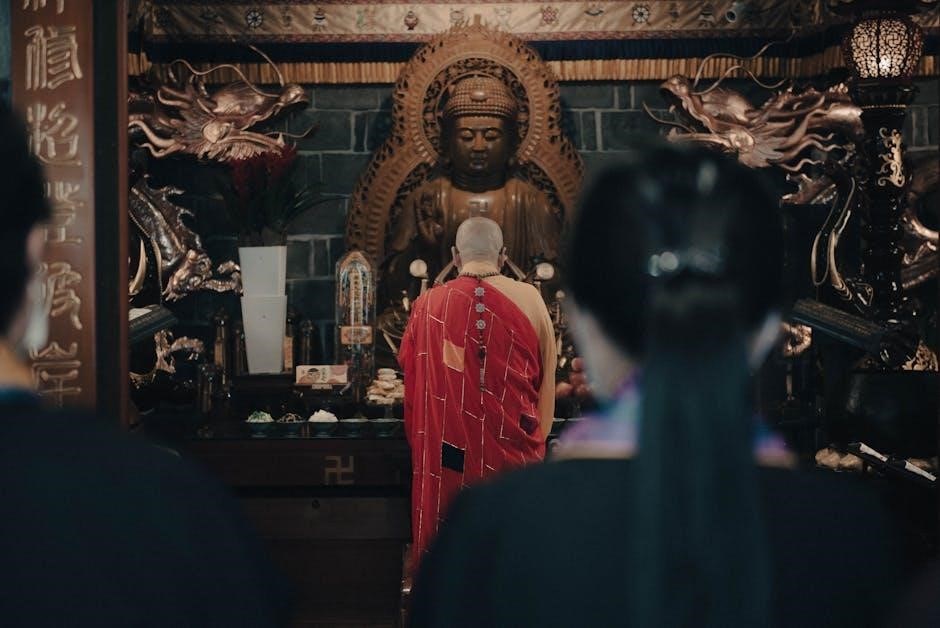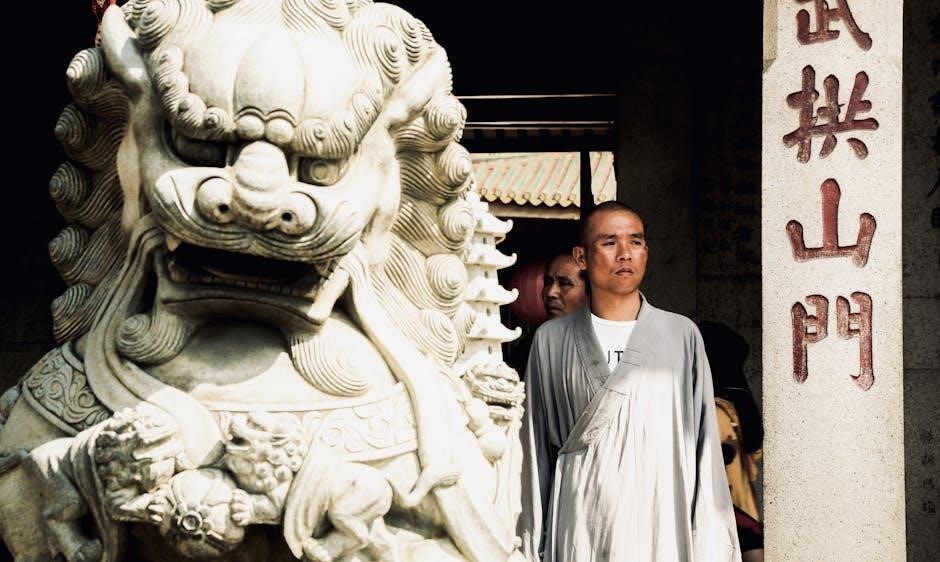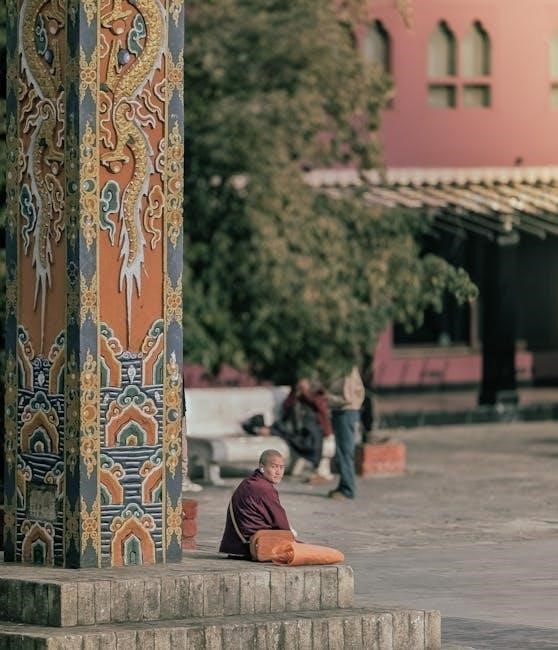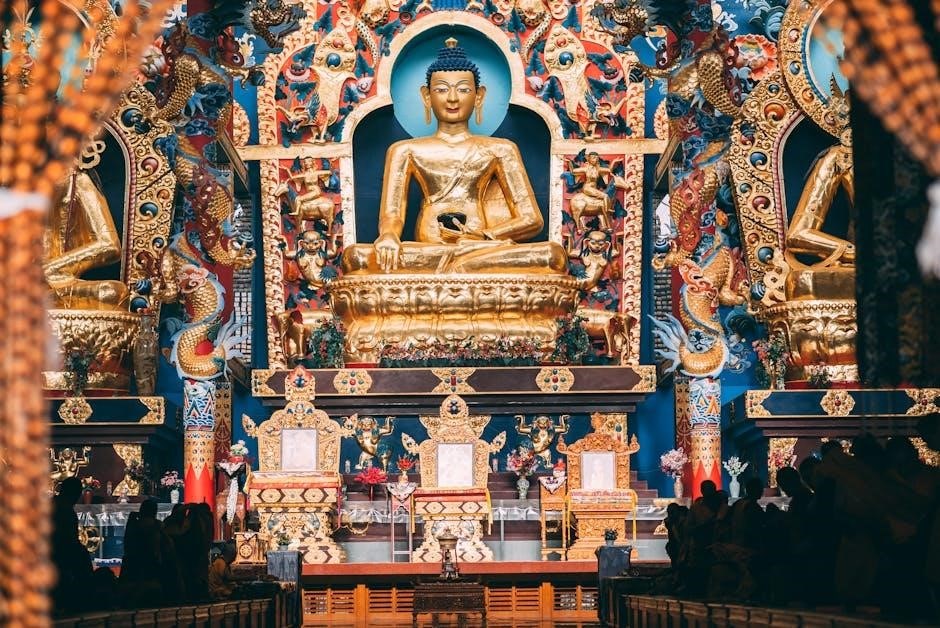The Monk is a martial artist class in D&D 5e, emphasizing speed, agility, and spiritual discipline. Monks harness Ki to perform extraordinary feats, blending physical prowess with mystical energy. They excel in hand-to-hand combat and mobility, making them versatile both in battle and exploration. This class is ideal for players who enjoy high-damage, fast-paced characters with unique abilities.
1.1 Core Features and Class Overview
The Monk class in D&D 5e revolves around mastering martial arts and harnessing Ki, a mystical energy. Core features include Unarmed Fighting, allowing weapon attacks without weapons, and Flurry of Blows, granting multiple attacks in a turn. Monks also gain Evasion at level 2, dodging area effects with Dexterity saves. Slow Fall and Extra Attack enhance mobility and combat efficiency. Ki manipulation enables abilities like Step of the Wind and Wholeness of Body, providing mobility and healing. The class excels in both melee combat and exploration, making it highly versatile and dynamic.

Choosing the Right Race for Your Monk
Choosing the right race for your Monk is crucial, as races like Halfling, Elf, Dragonborn, and Goliath offer beneficial traits that significantly enhance speed, resilience, and ability scores for optimal performance.
2.1 Ability Score Prioritization: Wisdom and Dexterity
For Monks, Wisdom and Dexterity are the most critical ability scores. Wisdom enhances AC, Ki abilities, and perception, while Dexterity boosts attack and damage rolls. Prioritize these scores during character creation and level-ups. Constitution is also valuable for survivability, but secondary to the core stats. Races and feats that boost these abilities are highly beneficial. Balancing these scores ensures optimal performance in both combat and exploration, making your Monk a formidable and versatile character. Proper allocation is key to maximizing your Monk’s effectiveness in D&D 5e.

Monk Subclasses and Their Unique Abilities
Monk subclasses like the Way of the Open Hand, Shadow, and Kensei offer distinct playstyles. Each archetype unlocks unique abilities, enhancing combat, mobility, or utility, defining your Monk’s identity.
3.1 Way of the Open Hand: Martial Arts Mastery
The Way of the Open Hand subclass embodies martial arts excellence, focusing on precise strikes and fluid movement. Monks of this tradition master techniques like Open Hand Technique, allowing them to push, trip, or knock enemies prone. They also gain Wholeness of Body, a healing ability fueled by Ki, restoring hit points at higher levels. Advanced meditation grants Tranquility, creating an aura of peace. This subclass excels at controlling the battlefield and delivering devastating counterattacks, making it ideal for players seeking a balanced blend of offense, defense, and mobility in combat.
Level Progression and Key Features
Monks gain powerful abilities as they level up, including increased movement speed, improved attack capabilities, and enhanced Ki manipulation. Key features like Slow Fall and Ability Score Improvements further enhance their durability and versatility in combat and exploration.
4.1 Slow Fall and Ability Score Improvements
Monks gain the Slow Fall feature at level 4, allowing them to reduce falling damage by five times their Monk level using a Reaction. This ability provides exceptional durability in combat and exploration. Additionally, Monks receive Ability Score Improvements at levels 4, 8, 12, and 16, enabling them to enhance their scores or gain feats. These improvements are crucial for optimizing Wisdom, Dexterity, and Constitution, which are vital for the Monk’s effectiveness in both combat and out-of-combat scenarios.
Combat Strategies and Build Optimization
Optimize your Monk by leveraging Agile Parry and Unarmored Defense for superior mobility and defense. Focus on enhancing Dexterity and Wisdom to maximize damage and survivability in combat scenarios.
5.1 Agile Parry and Unarmored Defense
Agile Parry and Unarmored Defense are cornerstone abilities for Monks, enhancing their defensive capabilities. Agile Parry allows Monks to use their reaction to increase Armor Class (AC) by their Dexterity modifier, providing exceptional evasion in combat. Meanwhile, Unarmored Defense enables Monks to add both Dexterity and Wisdom modifiers to their AC when not wearing armor, making them highly durable without relying on traditional armor. These features emphasize mobility and agility, allowing Monks to dodge attacks effortlessly while maintaining relentless offensive pressure. Together, they define the Monk’s unique blend of martial prowess and defensive mastery.

Multiclassing Options for Monks
Multiclassing for Monks allows blending their unique martial arts and Ki abilities with other classes, enhancing versatility and creating dynamic, powerful characters in D&D 5e.
6.1 Combining Monk with Other Classes for Maximum Effectiveness
Multiclassing a Monk with other classes can create highly versatile builds. For instance, combining Monk with Rogue grants access to Sneak Attack, enhancing damage output. A Monk-Fighter hybrid benefits from martial maneuvers and improved attack bonuses. Meanwhile, pairing Monk with Cleric or Druid leverages spellcasting to boost survivability and support capabilities. These combinations allow players to tailor their characters to specific playstyles, blending the Monk’s martial prowess with complementary abilities from other classes to achieve a balanced and powerful character.

Equipment and Gear Recommendations
Monks thrive with light armor, preferring mobility over heavy protection. Staves and short swords are ideal weapons, while magical items like belts of dex enhance their agility.
7.1 Weapons, Armor, and Magical Items for Monks
Monks excel with lightweight weapons like staves and shortswords, which complement their agility. Armor choices should prioritize mobility, with studded leather being a popular choice. Magical items such as Belts of Dexterity enhance their primary ability, while Amulets of Misty Step boost mobility. Bracers of Defense improve AC without hindering movement. Weapons like The Vorpal Sword or Mace of Disruption can add versatility in combat, though monks often rely on their unarmed strikes. Choosing gear that complements Dexterity and Wisdom ensures optimal performance.
Advanced Techniques and Ki Manipulation
Monks master advanced Ki techniques, enabling healing, meditation, and protective auras. These abilities enhance survivability and combat efficiency, making them formidable opponents at higher levels.
8.1 Healing and Meditation Abilities in Higher Levels
At higher levels, monks gain powerful healing and meditation abilities. Starting at 6th level, they can heal themselves as an action, regaining hit points equal to three times their monk level. This feature can be used once after a long rest. Additionally, at 11th level, monks can enter a special meditation called Tranquility, surrounding themselves with an aura of peace. These abilities enhance the monk’s survivability and support capabilities, making them more versatile and resilient in both combat and exploration. These advanced techniques exemplify the monk’s mastery of Ki manipulation and spiritual discipline.
Final Tips for Playing a Powerful Monk
Prioritize Wisdom and Dexterity for higher AC and attack bonuses. Choose a subclass that fits your playstyle. Manage Ki wisely. Focus on mobility and positioning in combat.
9.1 Build Examples and Playstyle Variations
Monks offer diverse build options, catering to various playstyles. The Way of the Open Hand excels in martial arts and crowd control, while the Way of Mercy provides healing and support. A Kensei build focuses on weapon mastery and versatility. For a tanky monk, consider multiclassing with Rogue or Fighter for extra survivability. A Halfling or Wood Elf race enhances mobility and stealth. Feats like Alert or War Caster can boost effectiveness. Experiment with gear like the Manual of Quickness or Bracers of Defense to enhance performance.





